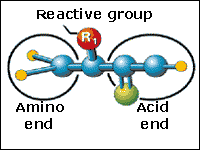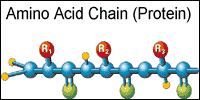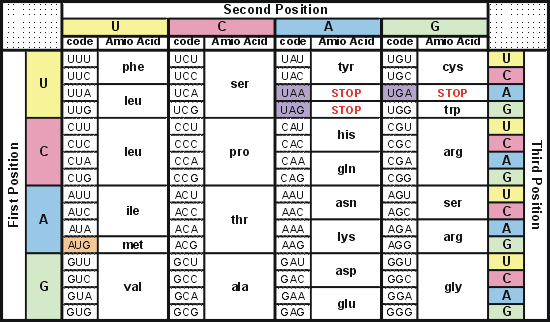
 Deana Namuth-Covert
Deana Namuth-Covert
The information for making a specific protein is encoded in a single gene. Genes are usually several thousand nucleotides long. There are thousands of genes on a chromosome. Nucleotides make up DNA, DNA makes up genes, and genes make up chromosomes.
 |
| A single amino acid has two ends and a reactive group. The reactive group is different for each amino acid. |
 |
| Amino acids link together in a chain to form proteins. |
Proteins
Proteins are chains of amino acids. The amino acid sequence in a protein determines how it will fold up into a specific structure. The shape or structure determines the function of a protein in the cell. A single amino acid has two ends and a reactive group. The reactive group is different for each amino acid. Amino acids link together in a chain to form proteins.
There are several roles proteins can play in the life of a cell. They can be enzymes and catalyze reactions, structural proteins and influence the shapes of cells and tissues, or regulatory proteins and regulate the expression of other genes.
Amino acids are found in the cytoplasm of the cell where protein production takes place. However, DNA is located in the nucleus stored as large chromosomes and cannot leave. In order, to get the genetic code from the nucleus to the cytoplasm, the cell reads the DNA and makes a message molecule called RNA. Making RNA begins when the two DNA strands for a gene unwind and separate. A protein present in the nucleus, called RNA polymerase, binds to one DNA strand and builds a complementary mRNA strand. When it does this, it places a Uracil (U) nucleotide instead of a Thymine nucleotide in the mRNA strand. This process is called ’ transcription’. When transcription begins, the DNA code is in the nucleus while the amino acids, which will compose the protein to be produced, are in the cytoplasm. A molecule called RNA polymerase reads the gene to be produced and makes a copy of the DNA sequence called RNA. The RNA strand is able to travel outside of the nucleus into the cytoplasm with the amino acids.
After transcription, the mRNA molecule travels outside of the nucleus into the cytoplasm. There, a protein building macromolecule called a ribosome binds to the RNA and reads the gene’s code three nucleotides at a time. Each group of three nucleotides is called a codon, and each codon codes for a specific amino acid. As you can see in the table, there are 20 different amino acids. Their abbreviations are listed in the right half of each column. The codons coding that particular amino acid are listed on the left half. There is usually more than one codon that codes each amino acid. For example, the amino acid serine, (’SER’ on the codon table) is coded by the codons UCU, UCC, UCA, and UCG. In this codon table, each possible codon is listed along with the abbreviation for the amino acid it codes for.

The ribosome travels down the mRNA, reading the codons and linking the appropriate amino acids together into a chain. This process is called ’ translation’. A complete protein has hundreds of amino acids in its chain and may have more than one chain. Once assembly is complete, the ribosome falls off of the mRNA message and the completed chain of amino acids folds up into its functional protein structure. The protein is now able to perform its job in the plant. A molecule called a ribosome is present in the cytoplasm and reads the RNA strand three nucleotides at a time. Each group of three nucleotides (codon) codes for a specific amino acid. As the ribosome reads the RNA strand it places the proper amino acids together in the order encoded in the strand. Once all of the amino acids have been linked together, the protein folds up into the shape dictated by the order of the amino acids. This shape gives the protein its function and allows it to do its work in the cell.
Comments
The captioned pictures are a good idea